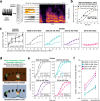Models optimized for real-world tasks reveal the task-dependent necessity of precise temporal coding in hearing
- PMID: 39632854
- PMCID: PMC11618365
- DOI: 10.1038/s41467-024-54700-5
Models optimized for real-world tasks reveal the task-dependent necessity of precise temporal coding in hearing
Abstract
Neurons encode information in the timing of their spikes in addition to their firing rates. Spike timing is particularly precise in the auditory nerve, where action potentials phase lock to sound with sub-millisecond precision, but its behavioral relevance remains uncertain. We optimized machine learning models to perform real-world hearing tasks with simulated cochlear input, assessing the precision of auditory nerve spike timing needed to reproduce human behavior. Models with high-fidelity phase locking exhibited more human-like sound localization and speech perception than models without, consistent with an essential role in human hearing. However, the temporal precision needed to reproduce human-like behavior varied across tasks, as did the precision that benefited real-world task performance. These effects suggest that perceptual domains incorporate phase locking to different extents depending on the demands of real-world hearing. The results illustrate how optimizing models for realistic tasks can clarify the role of candidate neural codes in perception.
© 2024. The Author(s).
Conflict of interest statement
Competing interests: The authors declare no competing interests.
Figures








Update of
-
Models optimized for real-world tasks reveal the task-dependent necessity of precise temporal coding in hearing.bioRxiv [Preprint]. 2024 Sep 16:2024.04.21.590435. doi: 10.1101/2024.04.21.590435. bioRxiv. 2024. Update in: Nat Commun. 2024 Dec 4;15(1):10590. doi: 10.1038/s41467-024-54700-5. PMID: 38712054 Free PMC article. Updated. Preprint.
Similar articles
-
Models optimized for real-world tasks reveal the task-dependent necessity of precise temporal coding in hearing.bioRxiv [Preprint]. 2024 Sep 16:2024.04.21.590435. doi: 10.1101/2024.04.21.590435. bioRxiv. 2024. Update in: Nat Commun. 2024 Dec 4;15(1):10590. doi: 10.1038/s41467-024-54700-5. PMID: 38712054 Free PMC article. Updated. Preprint.
-
Linear coding of complex sound spectra by discharge rate in neurons of the medial nucleus of the trapezoid body (MNTB) and its inputs.Front Neural Circuits. 2014 Dec 16;8:144. doi: 10.3389/fncir.2014.00144. eCollection 2014. Front Neural Circuits. 2014. PMID: 25565971 Free PMC article.
-
Hearing of modulation in sounds.Physiol Rev. 1982 Jul;62(3):894-975. doi: 10.1152/physrev.1982.62.3.894. Physiol Rev. 1982. PMID: 7045902 Review. No abstract available.
-
Spectrally specific temporal analyses of spike-train responses to complex sounds: A unifying framework.PLoS Comput Biol. 2021 Feb 22;17(2):e1008155. doi: 10.1371/journal.pcbi.1008155. eCollection 2021 Feb. PLoS Comput Biol. 2021. PMID: 33617548 Free PMC article.
-
Efficient Neural Coding in Auditory and Speech Perception.Trends Neurosci. 2019 Jan;42(1):56-65. doi: 10.1016/j.tins.2018.09.004. Epub 2018 Oct 5. Trends Neurosci. 2019. PMID: 30297085 Free PMC article. Review.
Cited by
-
Optimized feature gains explain and predict successes and failures of human selective listening.bioRxiv [Preprint]. 2025 May 28:2025.05.28.656682. doi: 10.1101/2025.05.28.656682. bioRxiv. 2025. PMID: 40501687 Free PMC article. Preprint.
-
A Deep Neural Network Trained on Congruent Audiovisual Speech Reports the McGurk Effect.bioRxiv [Preprint]. 2025 Aug 24:2025.08.20.671347. doi: 10.1101/2025.08.20.671347. bioRxiv. 2025. PMID: 40894527 Free PMC article. Preprint.
-
Individual differences elucidate the perceptual benefits associated with robust temporal fine-structure processing.Proc Natl Acad Sci U S A. 2025 Jan 7;122(1):e2317152121. doi: 10.1073/pnas.2317152121. Epub 2025 Jan 3. Proc Natl Acad Sci U S A. 2025. PMID: 39752517 Free PMC article.
-
Neuromorphic algorithms for brain implants: a review.Front Neurosci. 2025 Apr 11;19:1570104. doi: 10.3389/fnins.2025.1570104. eCollection 2025. Front Neurosci. 2025. PMID: 40292025 Free PMC article. Review.
-
A deep learning framework for understanding cochlear implants.bioRxiv [Preprint]. 2025 Jul 21:2025.07.16.665227. doi: 10.1101/2025.07.16.665227. bioRxiv. 2025. PMID: 40777303 Free PMC article. Preprint.
References
-
- Green, D. M. & Swets, J. A. Signal Detection Theory and Psychophysics Vol. 455 (John Wiley, Oxford, England, 1966).
-
- Siebert, W. M. Frequency discrimination in the auditory system: place or periodicity mechanisms? Proc. IEEE58, 723–730 (1970).
-
- Barlow, H. B. The efficiency of detecting changes of density in random dot patterns. Vis. Res. 18, 637–650 (1978). - PubMed
-
- Ernst, M. O. & Banks, M. S. Humans integrate visual and haptic information in a statistically optimal fashion. Nature415, 429–433 (2002). - PubMed
Publication types
MeSH terms
Grants and funding
LinkOut - more resources
Full Text Sources

